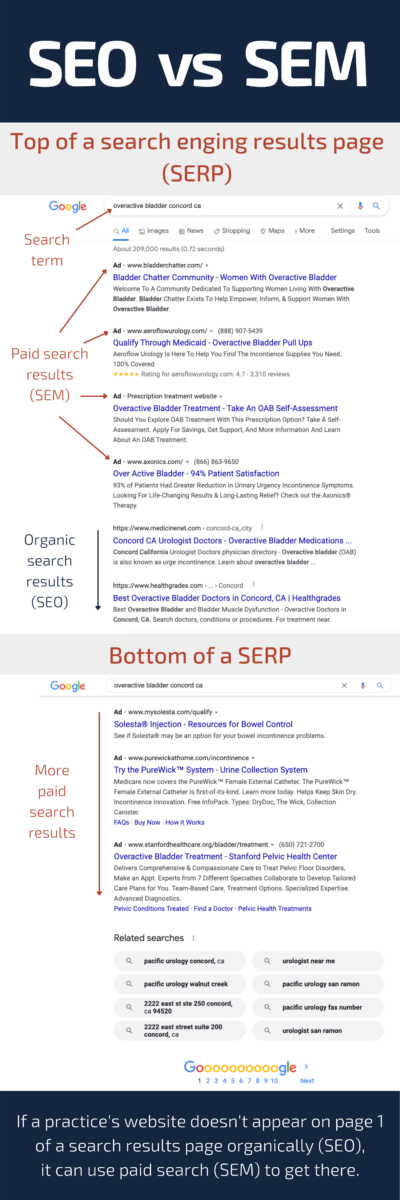 Part 7 in a series: Vanguard experts explain medical marketing
Part 7 in a series: Vanguard experts explain medical marketing
By Richard Wall, editor-in-chief
SEM involves how patients use search engines, how Google Ads work and how your medical website can bridge the two
The saying If you build it, they will come no longer applies to healthcare practice websites. Getting foot traffic now requires getting found online first, and that requires a more thoughtful online strategy, along the lines of, If you build it – and utilize search marketing techniques – they will come.
Research shows that 80% of consumers turn to the web for information on healthcare, primarily from search engines like Google, provider and hospital websites, or review sites like Yelp. The best way to be seen by these searchers (aka potential patients) is to use the search marketing techniques of search engine optimization (SEO) and search engine marketing (SEM).
SEO & SEM: 2 ways patients can find a doctor
- SEO is a free, though intricate way of using content and web page coding to optimize a website so that search engines find it organically (based on these site and page SEO practices) and drive more traffic to the site or specific webpages.
See our video on SEO for medical practices.
- SEM involves paid efforts to appear in search engine results pages (SERP) to gain visibility for a website or webpage. SEM brings up text ads that look very similar to normal search results copy that are triggered by the same search terms (or keywords) that SEO efforts use. SEM is commonly referred to as “paid search” or “pay-per-click (PPC) advertising,” as the search engine only charges advertisers when someone clicks on their ad.
Both are digital marketing methods that utilize an understanding of internet search to attract patients. SEO gets your website ranked on search engine results pages returned for a search query, with page 1 at the top being the ideal spot and within the top half of the page also good. SEM buys your ad a prominent slot on the SERP page 1.
The term search engine marketing has evolved from once meaning both paid and unpaid search marketing (unpaid being SEO) to now referring to only paid search marketing via ads. But SEM definitely relies on a refined understanding of and skill in SEO.
Are all online PPC ads SEM efforts? No. Facebook and other social media channels offer PPC ads, but they are not based on users’ searches, so they are not SEM. For example, Facebook ads show up to users browsing their news feed. The ads are not related to what a Facebook user is searching for online, which makes them less targeted than SEM ads.
The benefit of SEM for a doctor seeking new patients
SEM works by leveraging user intent on search engines like Google, Bing and Yahoo through paid text ads. The idea is that paid search entries show up at the top of the SERP and look nearly identical to organic search entries. If a user doesn’t know better, he or she may click on a paid entry not knowing the difference, though many people are aware they are ads and click on them anyway. It wasn’t until 2016 that Google started using a small “ad” icon in front of paid search ads. These paid search ads also appear at the bottom of the search results page, after organic search results.
While Google has greater search market share making Google Ads generally more productive, Bing Ads and Yahoo Search Ads are also SEM platforms. SEM on any search engine is a way for healthcare organizations to profitably, predictably and passively generate patients quickly. Here are just a few of the benefits of effective search engine marketing.
- Immediate results. Paid ads position the advertiser at the top or bottom of page 1 of search engine results pages, which is where PPC ads are located. Ranking on page 1 of Google searches organically can take months or even years, if at all. A practice without SEO-based visibility or brand recognition to rank on page 1 organically can instantly gain attention by harnessing paid ads.
- Highly targeted. What sets SEM apart is that healthcare organizations can employ highly targeted ad campaigns according to very specific criteria. This means that you not only just appear on the top of a search results page with your PPC ad, but at the right time when the right audience is searching. The more targeted you can make that ad, the better it will perform with potential patients. For instance, a PPC ad can target middle-aged women reluctant to see a doctor about urinary incontinence.
- Cost-effective. SEM is much cheaper than traditional advertising. Used effectively, search ads can trim the cost of acquiring a new patient while increasing revenues in turn.
- Easily adjusted. The beauty of the internet is that it’s malleable. If you’re running an ad with a low conversion rate, you can change or adjust it in real time to promote a slightly different message or an entirely new one. Have a special promotion or virtual event? Promote it to the intended audience for a few days. Have more patients than you can handle? Stop your online ads immediately.
- Metrics show effectiveness. Many metrics go into evaluating ad performance, and harnessing that data enables a practice to not only keep costs down but also learn a lot about its patients. You can see how people respond to different ad variations: do they click, spend more time on specific landing pages the clicked ad directs them to, or take further action while on your site? All of this allows for even further fine-tuning and more informed decision making about how you spend your marketing money to get patients in the door.
 Of course, no good thing is without its downsides. The problem with pay-per-click advertising is that while it’s quick and easy to set up a campaign, it’s very tricky to get right.
Of course, no good thing is without its downsides. The problem with pay-per-click advertising is that while it’s quick and easy to set up a campaign, it’s very tricky to get right.
In fact, even relatively small mistakes, such as utilizing too many keywords or failing to take into account user intent on landing pages, can end up costing a practice thousands of dollars in higher ad costs or wasted clicks. When running effective SEM campaigns, Google rewards advertisers who demonstrate SEM awareness with lower costs and higher visibility. You want your PPC ad to be as close to the top position as possible.
How keywords, bidding and click through rate work
One of the major elements SEM and SEO have in common is the power of properly used keywords. In an SEM campaign, you want to use the same keywords in your ads that are being used in online searches, as well as being used on the website page you are linking to. As with SEO that also relies on keywords, SEM keyword research prior to placing PPC ads is vital to success.
Keywords
A urology practice might want to use SEM ads to target females experiencing urinary incontinence. One choice would be to use the term “female urinary incontinence,” which receives an average of 320 searches a month. But if you used instead “urinary incontinence in women,” which is searched 1,000 times a month, you’ve just increased the potential efficacy of your ad threefold.
Bidding
You want keywords with a balance of high search volume and low competition. That’s because you won’t be the only practice wanting to use urinary incontinence in women, and you’ll be bidding against them to get top positioning for your ad. The more popular the keyword, the more you’ll have to pay to move your ad up to the top of the list. But you won’t know what others are bidding (nor will they know what you’re bidding), so you have to make an educated guess.
The intricacy of finessing popular and less-popular keywords against a monthly ad budget makes the case for doctors to enlist the services of an SEO/SEM expert.
Click through rate
But it’s not just about high bidding. Google and other search engines reward PPC savvy. The more your ad gets clicks, known as the click through rate (CTR), the more Google likes it. That’s because your ad is helping Google users find the quality, relevant information they’re looking for. Google will take that into consideration when determining how high up to place your ad among competing PPC ads. That brings more ad viewers and higher rates of PPC ad costs for Google.
SEM must take all these factors into consideration in constructing effective PPC ads.
Vanguard can help with your online marketing strategy
SEM is a powerful tool to grow a medical practice and to find patients while they are actively looking for healthcare information. After more than 25 years marketing medical practices, we know that to grow new patient volume requires patients finding you online – and we can optimize your website, its content and search ads effectively and efficiently.
Vanguard guarantees new patients
For nearly 30 years, our MedMarketLink program has worked with little to no paid advertising at all. Our focus on content marketing and patient education guarantees a 15%-30% increase in new patients, or we work for free.